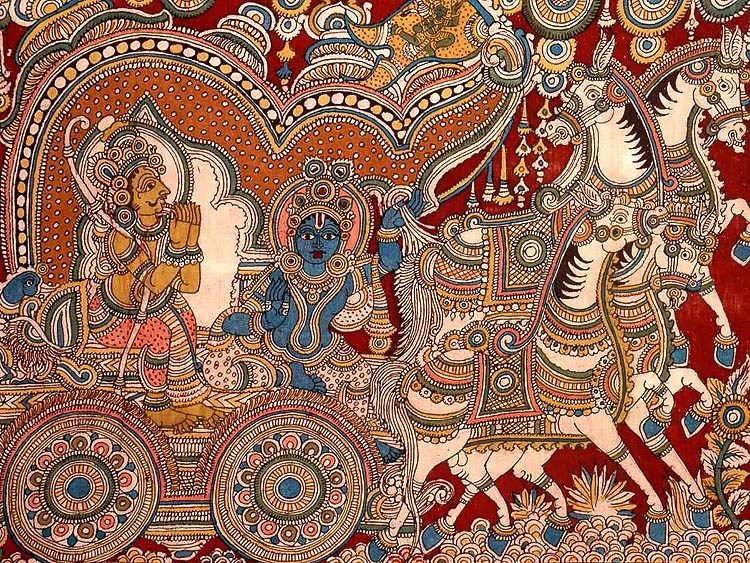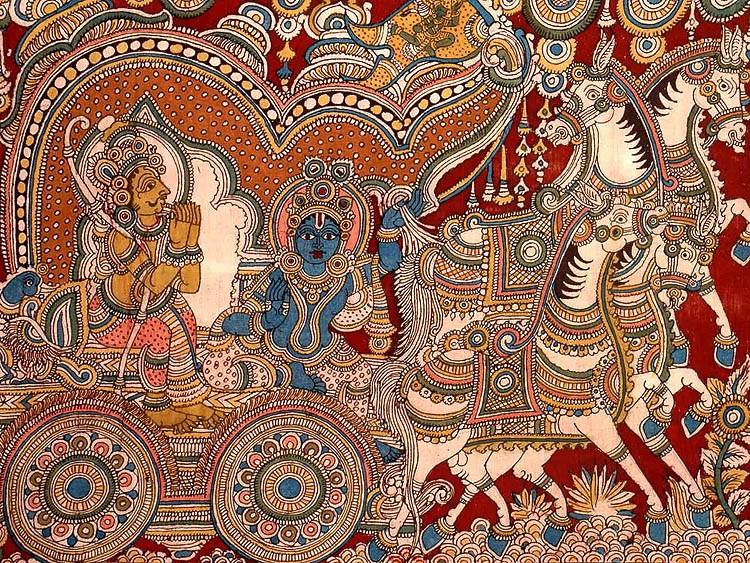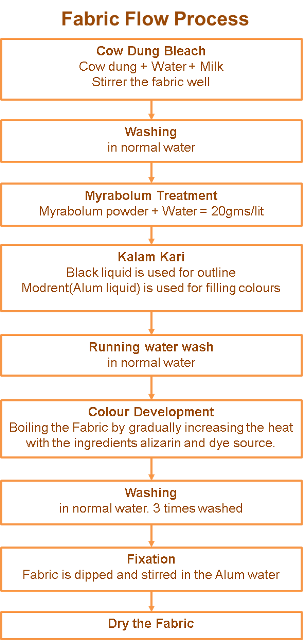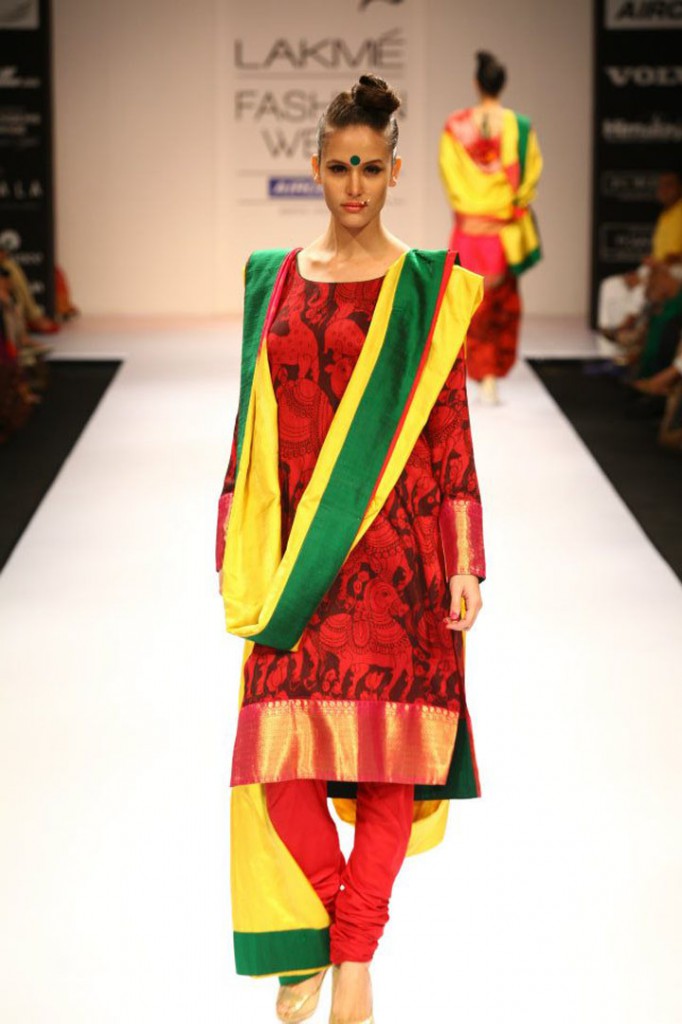
Kalamkari
Kalamkari is an ancient style of hand painting done on cotton or silk fabric with a tamarind pen, using natural dyes. The word Kalamkari is derived from a Persian word where ‘kalam‘ means pen and ‘kari‘ refers to craftsmanship. This art involves 23 tedious steps of dyeing, bleaching, hand painting, block printing, starching, cleaning and more. Motifs drawn in Kalamkari spans from flowers, peacock, paisleys to divine characters of Hindu epics like Mahabharata and Ramayana. Nowadays, this art is primarily done to create Kalamkari sarees.
History
Centuries ago, folk singers and painters used to wander from one village to other, narrating stories of Hindu mythology to the village people. But with course of time, the process of telling tales transformed into canvas painting and that’s when Kalamkari art first saw the light of day. This colorful art dates back to more than 3000 B.C. According to the historians, fabric samples depicting Kalamkari art was found at the archeological sites of Mohenjo-daro.
But, it was during the Mughal era when this style of painting got recognition. Mughals promoted this art in the Golconda and Coromandel province where skillful craftsmen (known as Qualamkars) used to practice this art, that’s how this art and the word Kalamkari evolved. Under the Golconda sultanate, this art flourished at Machilipatnam in the Krishna district of Andhra Pradesh and further was promoted during the 18th century, as a decorative design on clothing by Britishers in India.
Till today, many families in Andhra Pradesh continue to practice this art and this has served as the prime source of livelihood for them, over the generations.
The Making
The process of making Kalamkari involves 23 steps. From natural process of bleaching the fabric, softening it, sun drying, preparing natural dyes, hand painting, to the processes of air drying and washing, the entire procedure is a process which requires precision and an eye for detailing.
Cotton fabric used for Kalamkari is first treated with a solution of cow dung and bleach. After keeping the fabric in this solution for hours, the fabric gets a uniform off-white color. After this, the cotton fabric is immersed in a mixture of buffalo milk and Myrobalans. This avoids smudging of dyes in the fabric when it is painted with natural dyes. Later, the fabric is washed under running water to get rid of the odor of buffalo milk. The fabric likewise, is washed twenty times and dried under the sun. Once the fabric is ready for painting, artists sketch motifs and designs on the fabric. Post this, the Kalamkari artists prepare dyes using natural sources to fill colors within the drawings.
Incorporating minute details, the Kalamkars use ‘tamarind twig’ as pen, to sketch beautiful motifs of Krishna Raas-Leela, Indian god and goddesses like Parvati, Vishnu, Shri Jaganath; designs of peacock, lotus; and scenes from the Hindu epics like Mahabharata and Ramayana.
Colors of Kalamkari
Kalamkari art primarily use earthy colors like indigo, mustard, rust, black and green. Natural dyes used to paint colors in Kalamkari art is extracted for natural sources with no use of chemicals and artificial matter. For instance, craftsmen extract black color by blending jaggery, water and iron fillings which they essentially use for outlining the sketches. While mustard or yellow is derived by boiling pomegranate peels, red hues are created from bark of madder or algirin. Likewise, blue is obtained from indigo and green is derived by mixing yellow and blue together.
Types of Kalamkari
There are two identifiable styles of Kalamkari art in India – Srikalahasti style and Machilipatnam style. In the Machilipatnam style of Kalamkari, motifs are essentially printed with hand-carved traditional blocks with intricate detailing painted by hands. On the other hand, Srikalahasti style of painting draws inspiration from the Hindu mythology describing scenes from the epics and folklore. This style holds a strong religious connect because of its origin in the temples.
In recent times, two other types of Kalamkari patterns have also emerged, based on the states where it is created. Gujarat and Andhra Pradesh are two prime states in India, where two different types of Kalamkari patterns are done. The Andhra Kalamkari borrows design inspiration from forts, palaces and temples of India, along with motifs of animals and birds. While the Gujarat Kalamkari depict motifs of mythological characters like Krishna-Arjuna from Mahabharata, lord Krishna, lord Ganesha, lord Buddha etc.
Present Day Scenario
From the first representation of Kalamkari art as religious paintings, depicting Indian gods and goddesses to the process of gaining recognition during the reign of Mughal dynasty, and till today when Andhra Pradesh is the largest producer of Kalamkari; this art has come a long way.
In the past decade, due to the tedious technique involved in its making, Kalamkari art was losing its shine. The emergence of high on technology machine looms and printed textiles also escalated the extinction process of this art. But it was the fashion designers of the Indian fashion industry who came together to revive this art and helped artisans practicing this art in the state of Andhra Pradesh. Creative minds like Gaurang Shah beautifully portrayed Kalamkari sarees on the fashion runways which brought back this immortal art back in the limelight.
[youtube]https://www.youtube.com/watch?v=XGpCww-dxO8[/youtube]
Reference
Categories: Motifs & Embroideries



